Life on the Chernobyl Front
Frontier folk, wedged between the Belarus border and the nuclear exclusion zone, faced fierce live fighting, theft and intimidation.
The villages near Chernobyl, among the first Russia occupied in the early hours of its February 24 invasion of Ukraine, did not suffer like the suburbs around Kyiv.
Tidy hamlets, ranging from modest to poor, dot the region of Polis’kyi, with handfuls of brick or wooden houses clinging to each other along thin, pock-marked roads.
Remnants of a Russian Base – Anthony Borden in Luhovyky, 40km from Belarus border, 23 April '22
Russian forces sped through the area en route to their envisaged blitzkrieg of the capital, and seem to have had little time for the frontier folk here, wedged between the Belarus border and the exclusion zone of the encased nuclear plant.
Yet a trip through the area to distribute humanitarian aid reveals that locals nonetheless faced targeted searches, theft, shelling and deaths.
With scant food, they mostly survived on what they had or had grown, and had no electricity or communications. Some locals, terrified of rape, fled on foot from village to village, day after day, to avoid the occupiers, skirting fierce live fighting with their terrified children in tow.
“I cried the first two days of the occupation,” said Ruslana Morina, a primary school teacher in Vovchkiv, a village with some 440 residents 140 kilometres north of Kyiv. “And then I turned into a stone. I was afraid mostly for my two daughters.”
Although the Russians have now left, the 36-year-old said she always sleeps with the lights on for fear they may return.
Morina’s husband served in the Ukrainian army in 2014, fighting the Russians in the east. Targeting former servicemen and harassing their families was clearly a Russian priority, and Morina insists that local authorities had failed to destroy the records through which his veteran’s status was determined. (Ukrainian army sources said that Russian intelligence may have already had personnel lists.)
“The Russians came to me with a list and searched for him,” she said, adding that they sometimes barged in several times in a day. “But he was in Kyiv. I burned all the photographs I had of us together, and all the documents with his name, and I lied and told the Russians that he beat me and that we didn’t live together.”
Morina said her neighbour’s husband, also a veteran, was seized. No one knows what happened to him.
REPRISAL ATTACKS
Petro, a sprightly man in his 60s with bright eyes and a lively gap-toothed smile, lives in a village some kilometres away. He asked that neither his last name nor his village be mentioned, as his son is in the Ukrainian security services. He also refused to be photographed.
At 4:20 am on February 24, he said they heard missiles screaming towards Kyiv. Three rockets, presumably hit by Ukrainian anti-missile defence, fell in the field behind his house. By that afternoon, Russian soldiers – whom he identified as Buryat people from Siberia – had arrived. As an older man, he was not immediately harassed, but got increasing enquiries about his son.
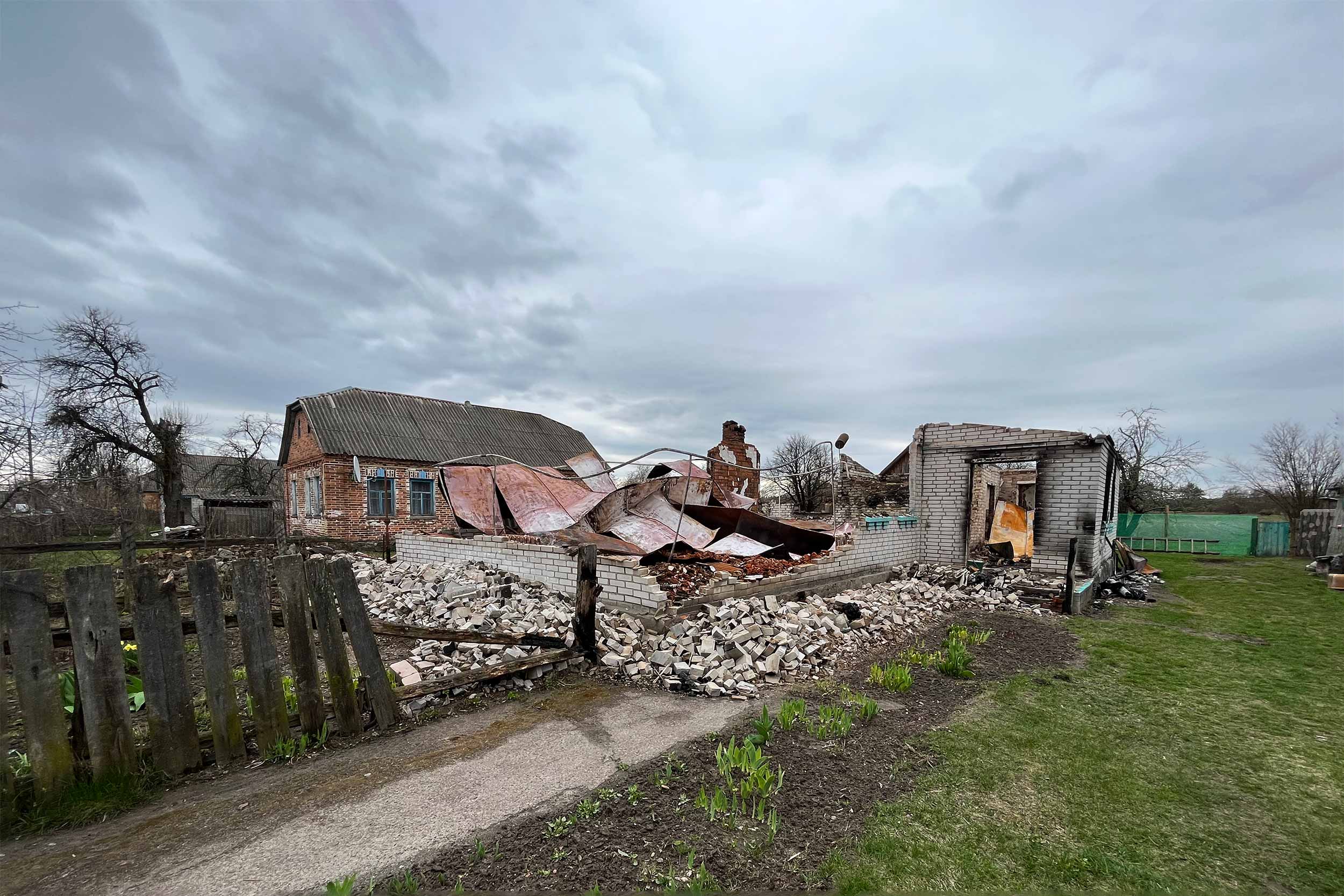
In mid-March, he continued, Ukrainian forces destroyed a number of Russian vehicles in the area. The next day, his modest brick house was destroyed by four rockets fired by helicopters. He was inside and hid behind the stove. He cannot recall exactly how he escaped.
“I had no time to be scared,” he said.
Walking around the ruins, he notes where each rocket hit. The rubble has been neatly piled to clear well-tended flower beds. Petro points out his only possessions that survived – a small array of crockery and his very agitated roosters. He now lives across the street, in a house vacated by a neighbour.
Halyna Mykytivna Semenenko, 79, is a former factory and post-office worker in the next village of Zirka (star). Under communism, it was named Red Star. A babushka with a formidable spirit, she was past any compromise with the occupiers.
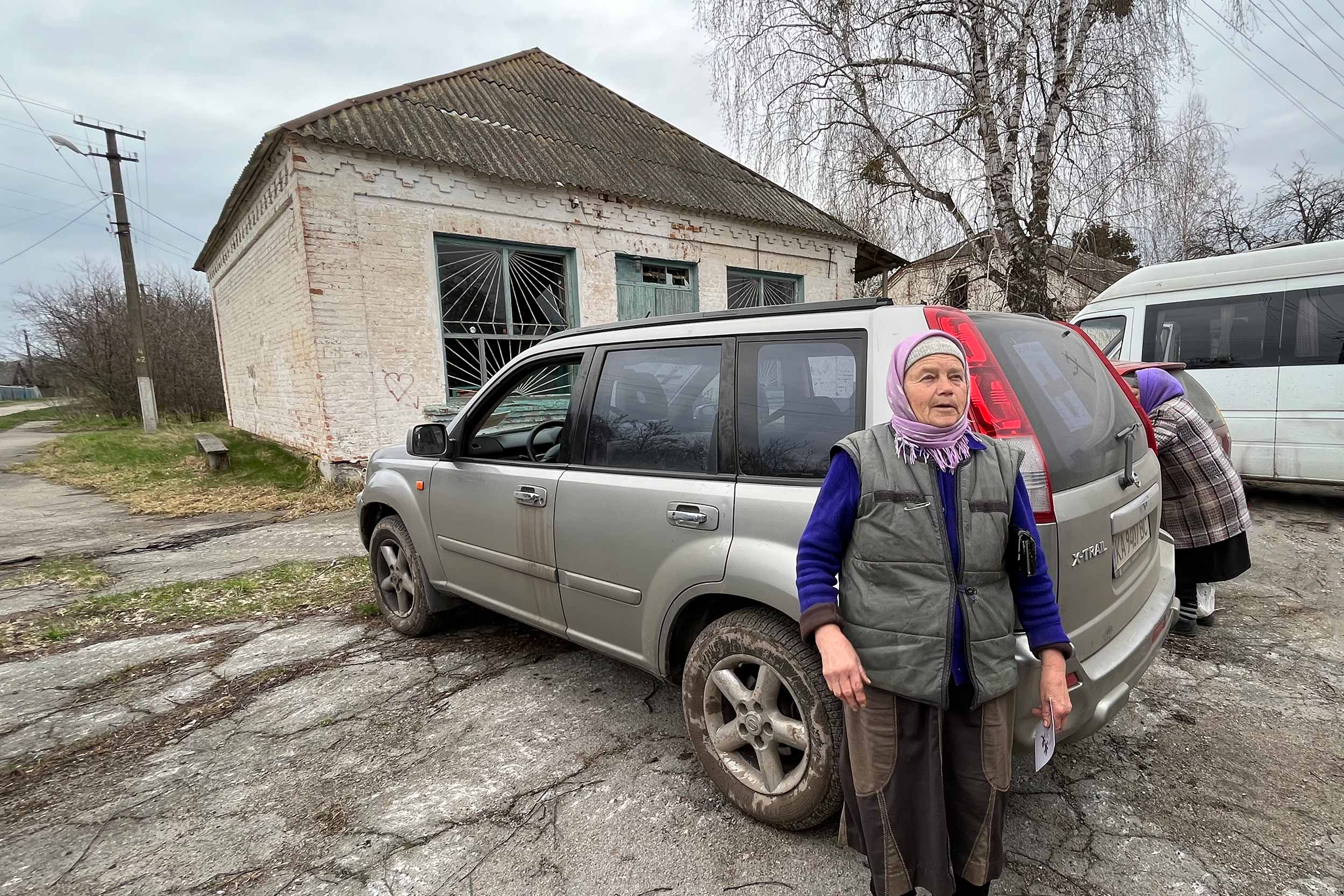
She said that for three days the soldiers came searching for “Bandera” – a reference to the Ukrainian nationalist leader who serves as the Russians’ primary bogey-man in their historical justification for war.
Her son-in-law also served in 2014 in Donetsk, and she, too, burned all his photographs. But she refused to destroy his uniform, and boasts that she found a secure hiding place for it instead.
On the gates of many houses in the area are painted words such as Дети (children) and Жилой дом (living house). Her sign said simply Люди (people). She said the Russians stole six chickens from her and robbed all the abandoned houses.
Her children urged her to leave, but she refused. When the soldiers demanded alcohol, she refused. When they asked for her robust German Shepherd dog, she said, “This is not a dog, this is my friend. I will fight you for him.” And when they told her to calm down as the war was over for her, she said, “For this to be true, you can surrender to me.”
The back end of the village is distinguished by a small water tower, painted blue and yellow after the Ukrainian flag. Crushed by a Russian shell, its defiant colours are still evident across the fields.
Nearby, a family backyard blends into a field planted with a fruit orchard. A bucolic scene but for the Russian position, running right alongside it.
Two foxholes look freshly dug by hand and never used. Two dozen ammunition boxes lie strewn on the ground, and a similar number of shell canisters. Nine squat howitzer shells are scattered, and nearby, four unspent tall Grad missiles lie in tall grass. In a ditch are several syringes.
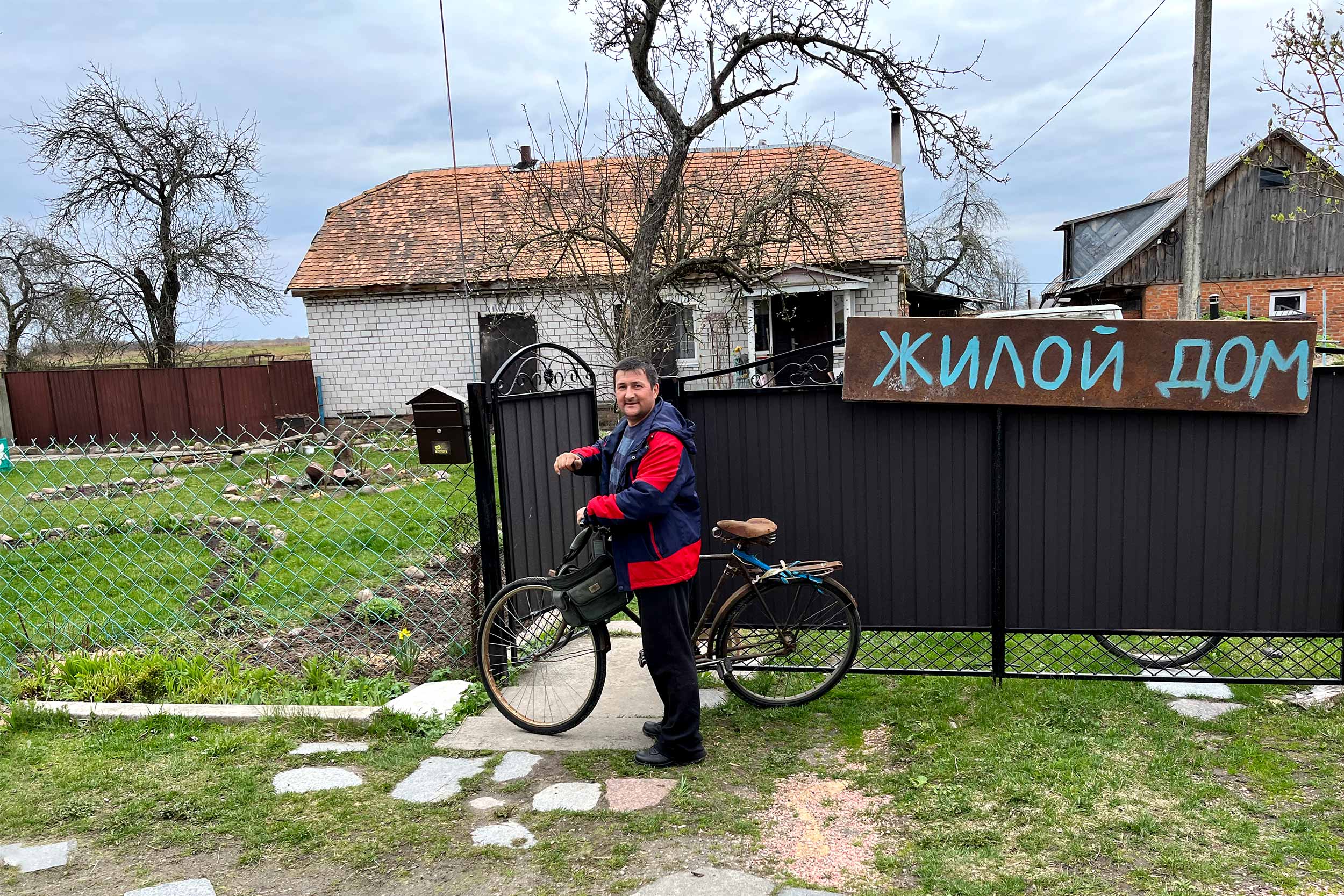
Ihor Denysiuk, 50, a builder and beekeeper who served in the Soviet army, said he recognized the young commander of the unit as Kazak.
The soldiers destroyed his car, forced him to drink vodka and one said, “Every Ukrainian man from 18 to 60 should be shot.”
Denysiuk recalled that hundreds of missiles were launched from this field, day and night. One landed in a neighbouring village, directly striking a shelter and killing five.
The Russians collected the bodies of comrades killed in clashes, he continued, claiming that some badly wounded fighters were shot by them. The corpses were either dumped in a nearby pond or later, burned in a mobile crematorium. Denysiuk added that villagers also found the remains of burned passports in a fireplace.
“Without a body,” he said, “they don’t have to pay the family compensation.”
Hard by the exclusion zone is a hub for the Ukrainian highway department, where according to former employee Mykola Martynenko, 36, many hundreds of vehicles were parked. It had a large covered garage, several workshops and a number of other office buildings and facilities.
In the early days of the invasion, it was taken over by Russians who used it to park their own vehicles. But on March 16, it was attacked with remarkable accuracy by Turkish-made drones, the famous Bayraktars so cherished by the Ukrainian army.
Martynenko said he was killing a pig to share food with the neighbours when he heard the deafening roar of the attack. He shakes his head in recollection of the ear-shattering sound.
Only two tanks were in evidence, but the legacy of the impact on transport vehicles, weaponry and ammunition is evident, spread across an enormous moonscape of devastation. In various outbuildings, computers and TV screens lie on the ground, mingled with rations and other Russian goods.
In a makeshift dormitory, constructed from birch trees and wood stripped from ammo boxes, the evidence of a hasty departure is clear, with clothes, underwear and a pair of sliders strewn across the floor.
Martynenko said that the Russians shelled ten houses in the neighbouring village in reprisal for the drone attack. After they fired on locals trying to douse the flames, the entire village fled to spend the night in the forest.
OPENING UP
The drive up from Kyiv, circumnavigating bombed out bridges and skirting destroyed Russian tanks, takes its toll on vehicles and passengers alike. Pontoon crossings had only been in place for a week. Although the most distant village should be no more than a two-hour drive from the capital, the trip took nearly 14 hours, including handing out aid but delayed also by much war wreckage.
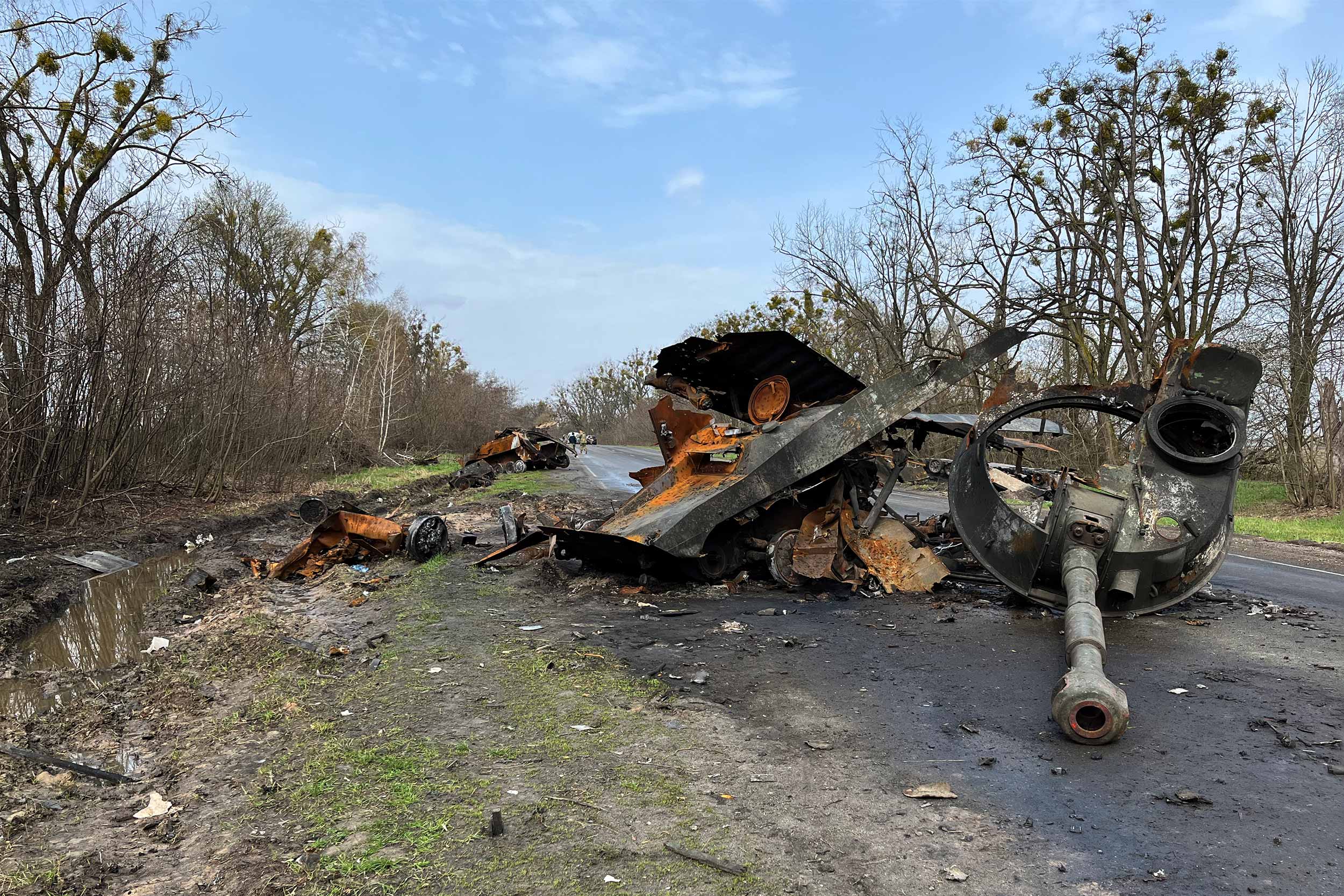
Around 20 territorials accompanied ten volunteer aid workers, including from a Ukrainian group, the Platch Foundation.
The villagers for the most part seemed well and in good spirits. Under occupation, they had relied on their own produce as well as stored food, and shared what they could.
But medicine was in particularly short supply and electricity had only just returned on the day of this visit. The local TV tower, near Maryanivka, lay toppled and the only mobile phone coverage came occasionally via roaming, with text messages popping up reading, “You’re in BELARUS. . . . Have a good trip.” The border is only 30 kilometres north.
In Maryanivka, the soldiers joined aid workers in passing out foodstuffs. Boxes of nappies and other household supplies were laid on the steps of the community centre, itself decked in faded blue and yellow and adorned with a tired Ukrainian flag.
One territorial popped over to the nearby country store to buy instant coffee and chocolate for the long journey back. Resupply had only been possible over the past few days.
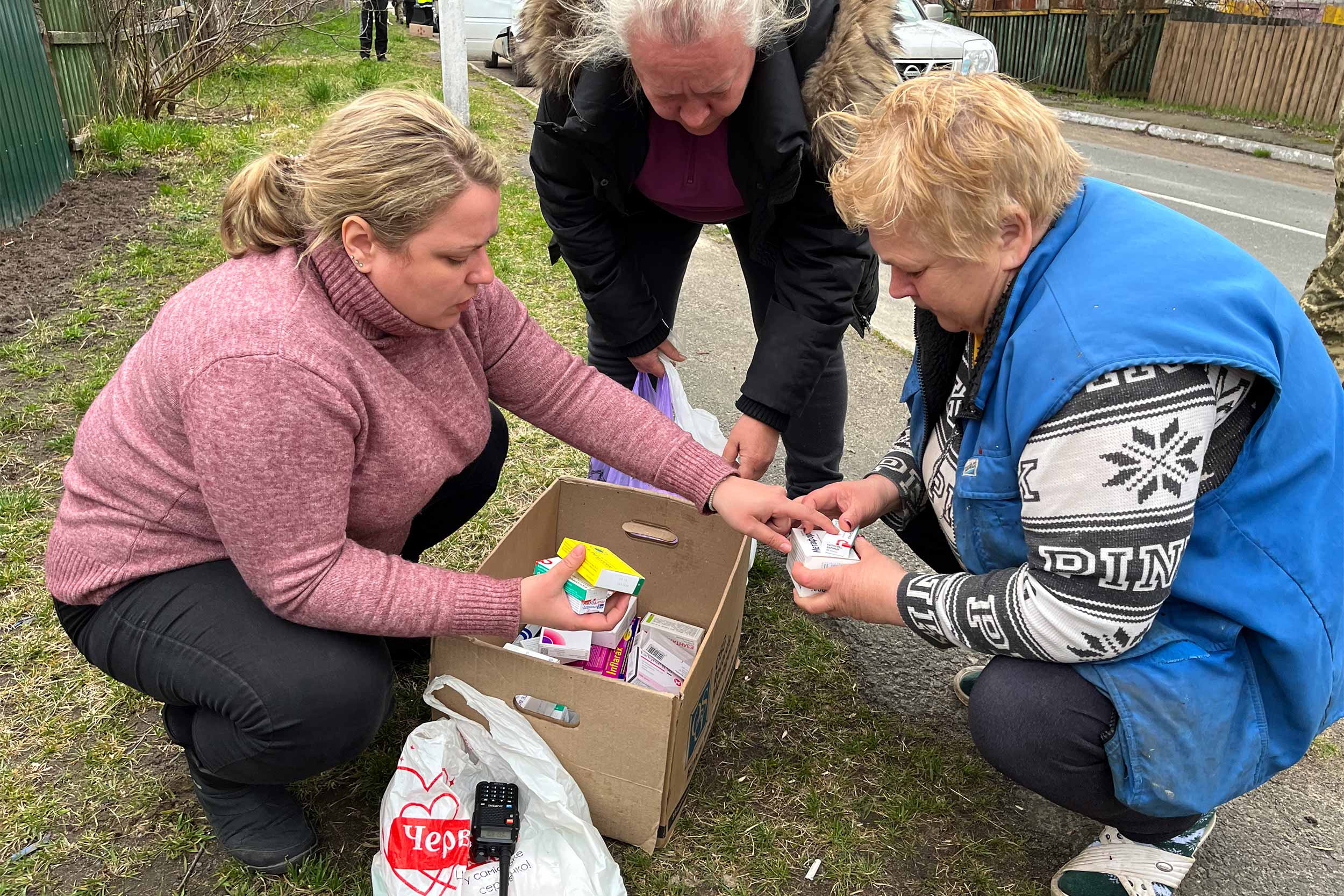
Lyudmyla Yankina, a human rights activist with training as a nurse and a psychologist, had organised the journey. She and her long-time friend Irina Sergeeva, 39 – a former communications professional and now a territorial defence officer – had already made a first trip to the area a week earlier
Yankina said she has raised nearly 35,000 US dollars from around the world for medicines, supplies and food aid.
“These people have not had anything for 60 days, no communications, no supplies, nothing,” Yankina continued. It had been almost impossible to reach these villages, and on their first trip, locals were very reserved and she had to win their confidence.
“I told them, I am speaking your language, I am speaking Ukrainian, I am here to help. And that’s why it was so important for me to visit them and make a little celebration for them, they didn’t have any chance before to smile,” she says. The Easter cakes delivered the day before the holiday were especially appreciated.
This visit revealed an anecdotal picture. More systemic reporting would turn up more examples of harassment, killings, perhaps rape. Three core principles of the occupation – thievery, targeting veterans of 2014 and reprisals – held here, too, as in other areas of Kyiv and Ukraine.
But it appears the region was spared the worst, at least for now.
As the Russian commander told Denysiuk, the builder in Zirka, as they were leaving, “I’m not saying goodbye. I will come back.”
Translation and additional reporting by Yevgen Nasadyuk
